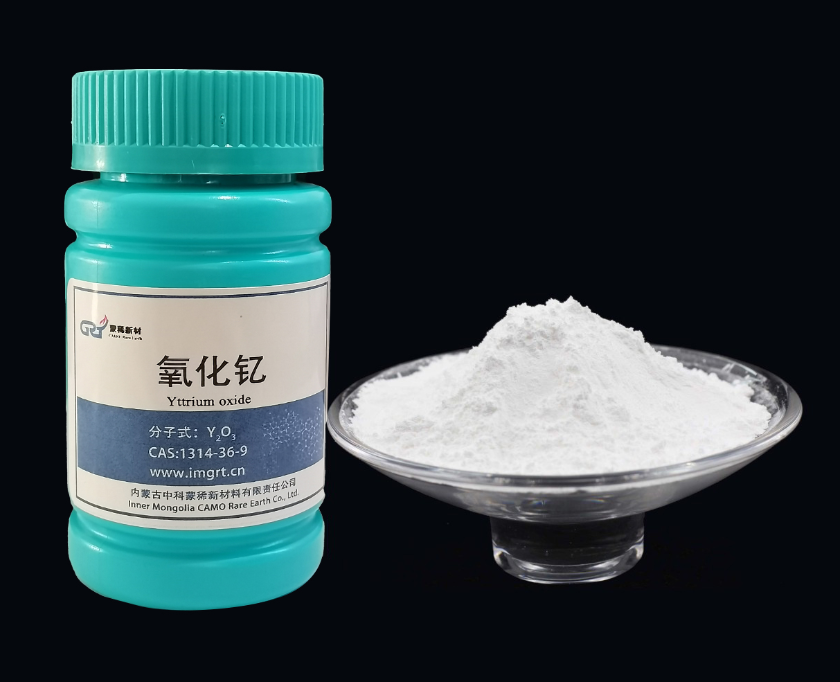Product Details
CAS: 1314-36-9
MF: Y2O3
Appearance: White fine powder
Packing: 500kg / bag, 1000kg / bag
Purity: Y2O3/TREO≥99.999%
Wholesale Trustworthy Manufacturer Supply Yttrium oxide 1314-36-9 On Stock
- Molecular Formula:Y2O3
- Molecular Weight:225.81
- Appearance/Colour:White fine powder
- Melting Point:2410 °C
- Boiling Point:81-83 °C
- Flash Point:12 °C
- PSA:43.37000
- Density:5.01 g/mL at 25 °C(lit.)
- LogP:-0.30600
Yttrium oxide(Cas 1314-36-9) Usage
|
Preparation
|
Yttrium oxide is produced as an intermediate in recovery of yttrium from xenotime and monazite (See Yttrium, Recovery). The oxide is produced after separation of rare earth sulfates obtained from digesting the mineral with sulfuric acid on a cation exchange bed, precipitating yttrium fraction as oxalate, and igniting the oxalate at 750°C. Yttrium oxide also may be obtained by thermal decomposition of yttrium nitrate.
|
|
Flammability and Explosibility
|
Nonflammable
|
|
Safety Profile
|
A poison by intraperitoneal route. See also YTTRIUM and RARE EARTHS.
|
|
Physical Properties
|
White powder; body-centered cubic structure; density 5.03 g/cm3; melts at 2,436°C; insoluble in water; soluble in dilute acids.
|
|
uses
|
▼ ▲ Industry Application Role/benefit Gas lighting Manufacture of gas mantles Effective component/has extremely high temperature stability Inorganic synthesis Manufacture of Yttrium compounds Raw material/source of Yttrium Ceramic Manufacture of pure ceramic Raw material or additive/has extremely high temperature stability and outstanding resistance to alkaline melts Manufacture of other ceramic material (Si3N4, AlN, ZrO2, etc.) Multilayer ceramic capacitors Display materials Color TV picture tubes Additive material/used as raw material to make Eu:YVO4 and Eu:Y2O3 phosphors that give the red color Field-emission displays Plasma display panels Flat-panel displays Cathode ray tube screens Insulator Insulator coating Effective component/extremely thermodynamically stable and resistant to many reactive molten metals Laminated insulator Nuclear technology Coating material for graphite in nuclear technology Main component/extremely thermodynamically stable Diluting uranium oxide for nuclear fuel rods Diluting agent/ Yttrium oxide can form a solid solution with uranium oxide Refractory Coating material for high-temperature applications Main component/extremely thermodynamically stable Others Manufacture of steel, non-ferrous alloys and iron Additive/extremely thermodynamically stable Manufacture of IR and UV translucent glass Manufacture of high-temperature superconductors Preparation of permanent magnets Additive Prospective solid-state laser material Dopant / lasers with ytterbium allow the efficient operation both in continuous operation and in pulsed regimes Making Yttrium iron garnets for powerful microwave filters Raw material/source of Yttrium Ultrafast sensors used in g-ray and x-rays Additive Paints and plastics Additive/decreases UV degradation
|
|
General Description
|
Yttrium oxide is an excellent mineralizing agent for spinel formation. It has a high melting point(2450oC), chemical stability, low coefficient of thermal expansion, high transparency for both visible (70%) and infrared (60%) light, low cut off energy of photons.
|
InChI:InChI=1/3O.2Y/rO3Y2/c1-4-3-5-2

